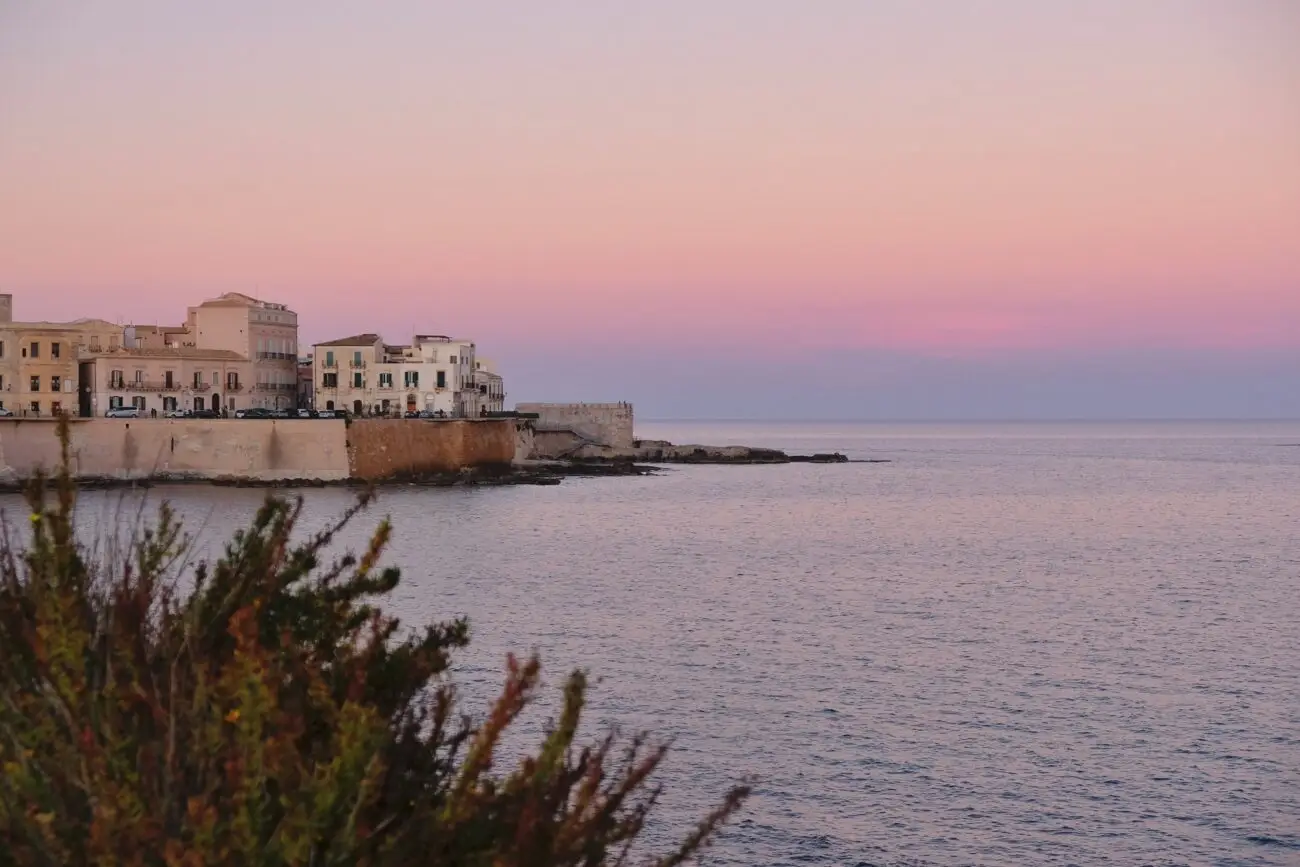Ortigia, Sicily is one of those rare places that lingers long after you leave. A sun-drenched island of Baroque facades, winding alleys, and sea-scented air, it invites you to slow down, get lost (even though you can’t), and savor the everyday magic. Many people come just for the day—but to truly feel Ortigia’s charm, you need to stay a little longer and let it unfold at its own pace.
Whether you’re escaping a packed schedule, chasing corners with your camera, or traveling light on a budget, Ortigia delivers quiet wonder in spades.
As a solo female traveler, I felt at ease wandering its cobbled streets—even at dusk, passing nonnas at their doorways like guardians of the old world. One thing I’ll always miss about Italy: the simple joy of greeting strangers with a buongiorno or buonasera and being met with a warm smile in return. And of course—the cats. Well-fed, well-loved, and fully in charge.
It didn’t take long to understand why I fell in love with Ortigia, Sicily.
Arriving in Ortigia: Sunshine, Stairs, and a Sea View
After a smooth one-and-a-half-hour train ride from Catania to Siracusa (Syracuse in English), I arrived ready to shake off some lingering travel nerves. While Google promised a 20-minute walk to my hotel, I opted for a €30 taxi—after a no-change hiccup with a driver who speak-ah no eeng-lish—which made things easier in the end.
Siracusa is a charming city on Sicily’s eastern coast, full of ancient ruins, coastal views, and centuries of history. Just across a short bridge lies Ortigia, its historical heart—though technically, it’s a small island just off the mainland. What Ortigia lacks in centrality, it makes up for in atmosphere: cobblestone lanes, baroque buildings, salty sea air, and the irresistible sense that you’ve stepped into another era.
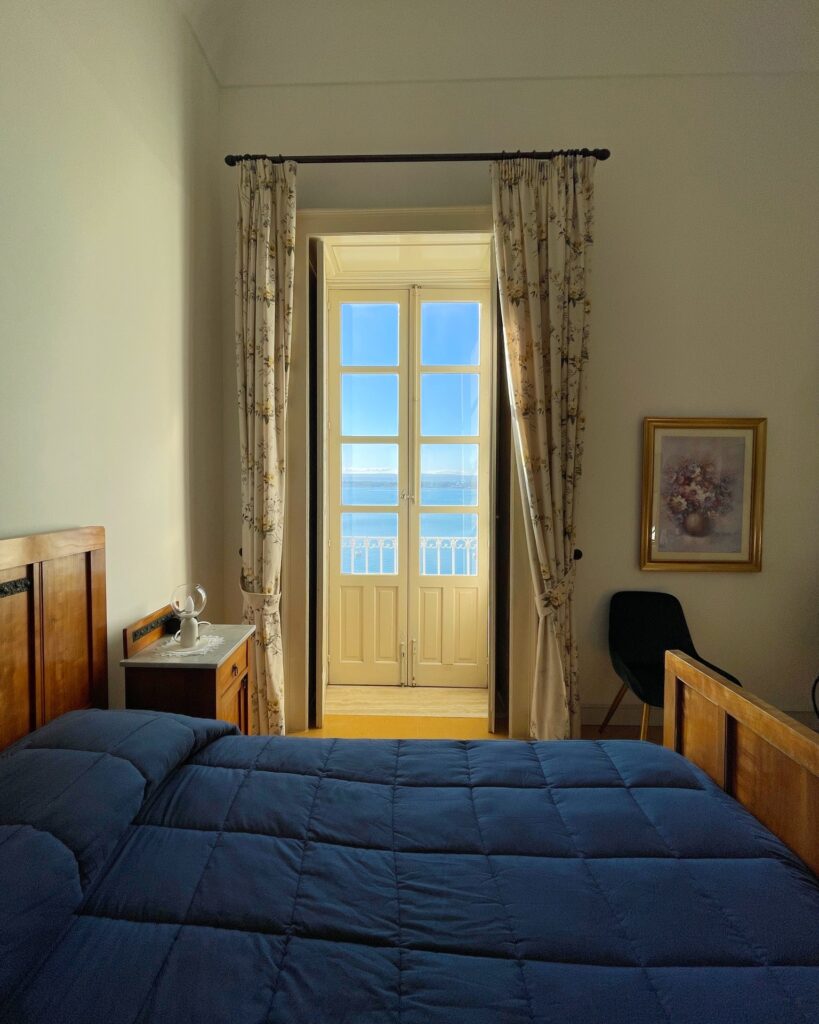
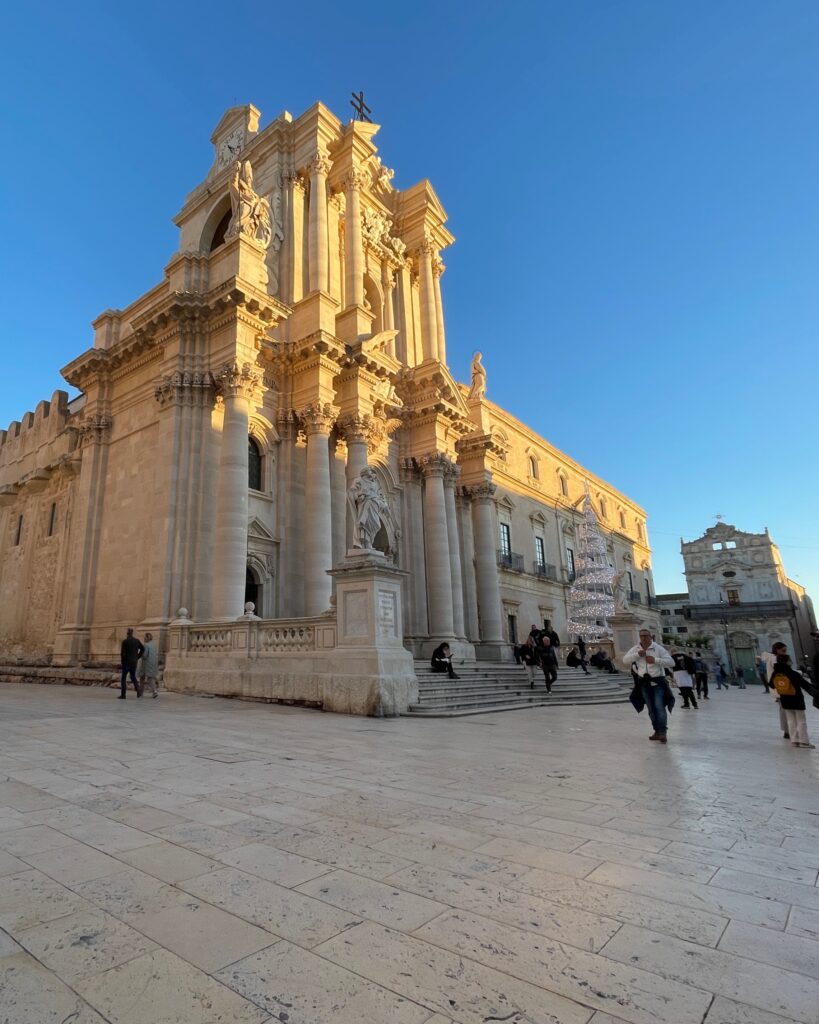

I added Ortigia to my itinerary after spotting it in Indiana Jones and the Dial of Destiny—and I’m glad I did. My B&B, Camere A’ Marina, sat on the top floor of a sea-facing building. As expected in Italy, it came with a side of cardio: no elevator, just winding stone stairs. Thankfully, the hotel caretaker materialised like a travel fairy and helped with my luggage.
When I finally stepped out to explore, the main piazza took my breath away. Piazza Duomo is a grand, sunlit square anchored by the Duomo di Siracusa—a majestic cathedral that began as a temple to Athena and now dazzles with its baroque façade. Its current form is a striking symbol of the city’s resilience, rebuilt after the devastating earthquake of 1693. As the sun dipped and turned the limestone walls golden, I stood there quietly, already falling for this place.
Day 2: Market Mornings, Missed Architecture, and Ceramic Fish
The next morning started with a visit to the buzzing Ortigia market—alive with the sounds of shouting vendors, the scent of citrus and cheese, and locals on a mission. I had just one goal: Caseificio Borderi, the sandwich shop TikTok had collectively lost its mind over.
The queue was long and moving fast, and true to form, I panicked under pressure and pointed to the first thing I vaguely recognised on the menu. No regrets, though—it was delicious. I parked myself on a nearby bench to eat, and was quickly joined by a cat with a rather suspicious limp. It was clearly faking it to score a bite. Naturally, I gave in.

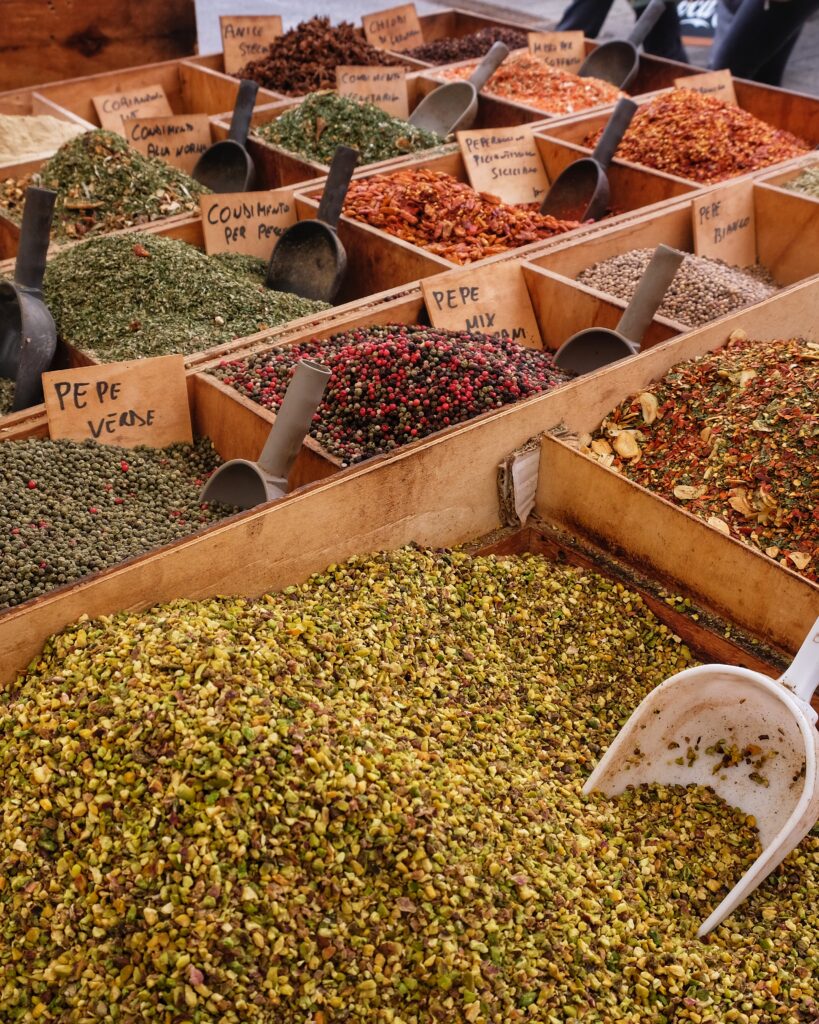
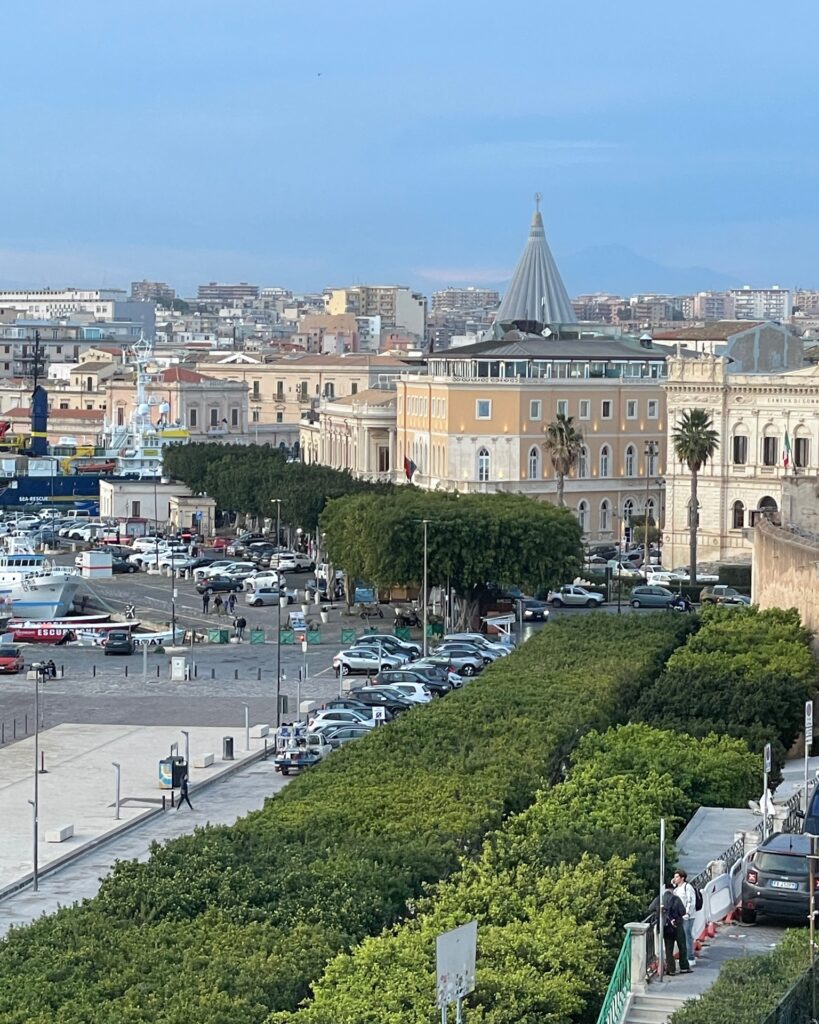
Later that afternoon, I wandered across the bridge back into mainland Syracuse (Siracusa), drawn by a striking pointed structure on the skyline—the Sanctuary Basilica of Our Lady of Tears (Basilica Santuario Madonna delle Lacrime). I gave up not far from it—more than halfway there—but reaching it required a big detour around a busy road, and I was tired. I assumed—like most things during the afternoon siesta—it was shut.
Big mistake. A quick search back at the hotel revealed it to be a bold piece of postmodern architecture—exactly the kind of weird-meets-wonderful building my design-loving brain would have adored.
With time to spare before dinner, I popped into Fish House Art, a ceramic shop filled with handmade pieces inspired by the sea—fish, squid, coral, even sea urchins—all crafted with personality and charm. The place was run by an elderly man and his equally stoic cat, who sat by the counter like a shop assistant with better boundaries.
That evening, I met up with a new Australian friend I’d met a few days earlier on the Valley of the Temples tour. We had dinner at Pizzeria Schiticchio, a relaxed and cosy spot known for its pizza. We swapped stories over slices, grateful for good company and good food in a place that already felt a little like home.
Day 3: Archaeological Chaos, Thunderstorms, and a Very Wet Walk
The plan was simple: get my laundry done early, then head to the Archaeological Park of Neapolis (Parco Archeologico della Neapolis) to meet my friend from the night before. But—as with most travel days—the laundry had other plans. My load took forever to dry, and I ended up running late.
By the time I arrived at the park—home to the famous Ear of Dionysius (Orecchio di Dionisio)—I was alone. My friend had already gone in ahead. I was especially looking forward to this visit because, yes, the Ear of Dionysius made an appearance in Indiana Jones and the Dial of Destiny. There’s something surreal about standing in a cinematic location you’ve only ever seen on a giant screen, half-expecting Harrison Ford to round the corner at any moment.
But it wasn’t Indy who showed up—it was a storm.
Barely fifteen minutes into exploring the park, the sky darkened and the wind came alive. Leaves whipped through the air, hats went flying, and people scattered in search of shelter. Then came the rain—not a drizzle, but the kind of downpour that felt like the sky had upended a giant pail over all of us.
I followed a small group into a guardhouse. We were dripping wet but slightly less miserable—until a security guard stormed in and barked something in rapid-fire Italian. What followed was a full-blown, spit-flecked standoff between her and one of the visitors. And I mean spit-flecked—I was standing between them, catching every syllable and a fair bit of the spray.
It was like being dropped into the middle of a live-action Sicilian soap opera. Arms were flailing, words were flying, and the drama was Oscar-worthy. I didn’t catch a single word, but the message was clear: leave. The tourist pleaded. The guard roared.
And just like that—end scene. The tourist backed down. The guard had won. I gave them both a respectful distance as I slipped back out into what was now, thankfully, a drizzle—feeling like I’d just survived a very damp, very dramatic masterclass in Sicilian confrontation.
The storm had eased into a moody drizzle. I remembered a sheltered spot near the entrance and made my way there. My friend was already waiting—just as drenched and windblown as I was. We waited out the worst of it together before she headed back to Catania.
I, stubborn as ever, went back in to finish the circuit. The rain returned. I tried booking an Uber, but after half an hour in soaked jeans and a dripping ponytail, I gave up. Thank God for my $60 Shein trench coat—it kept my top dry. Who needs Burberry when your budget coat shows up and performs in a storm?
I made the long walk back to Ortigia, past fallen branches, cracked boat masts, and a half-sunken pier. The sky remained grey and sulky, and the streets were eerily quiet. Back in my room, I discovered that the storm had ripped the shutters off my tiny balcony. I messaged my host, who kindly sent someone to clear the damage. I peeled off my soaked layers and took the hottest shower of my life. It was only 3:30 p.m.
That evening, still raining, I ventured out again—wrapped in layers and optimism. The wet streets shimmered under the streetlights, and as I wandered, it struck me: there’s something about rain that makes even empty streets look like paintings.
I ended up at Zenzero, a tiny vegan restaurant run by an elderly couple. I was their only guest. The food was warm, simple, and comforting—exactly what I needed. After dinner, I strolled a little more, then returned to my room, crawled under the covers—and eyed the now-shutterless window, which rattled menacingly every time the wind picked up. Just in case, I wedged a chair in front of it like I was bracing for a ghost or a cartoon burglar. It didn’t budge. Crisis averted. I drifted off to the sound of wind whistling through the cracks, equal parts eerie and oddly comforting.
Day 4: Baroque Beauty in the Rain — Ragusa, Modica, and Noto
I woke up to the familiar sound of wind curling around the window. The rain hadn’t stopped. At this point, I’d accepted that the rest of my Sicilian trip would be wrapped in shades of grey.
Today’s plan: a transport-only Baroque towns tour covering Ragusa, Modica, and Noto. I’d booked it the day before—one of those convenient set-ups where a driver drops you off in each town for a couple of hours and picks you up again. No tour guide, no group selfies, just a route and free time. Perfect.
Our driver—a handsome man in a perfectly tailored suit—greeted us with a polite nod and little fanfare, like it was completely normal to look like a wedding guest while chauffeuring three rain-drenched women around southeastern Sicily. It was just me and two older Italian ladies who didn’t speak a word of English. But we exchanged smiles, gestures, and one or two shared sighs about the weather. I hoped the skies might lighten.
They didn’t.
Ragusa: Empty Streets and Racing Raindrops
Our first stop was Ragusa Ibla, the historic heart of the town. We arrived early, before most cafés or shops had even thought of opening. The streets were quiet and dripping, the kind of stillness that only rain can bring.
I wandered solo, winding through alleys framed with pale stone buildings. My umbrella struggled against the wind, flapping like a weak-winged bird, while I focused on not slipping on the slick cobblestones. The walk to the viewpoint was uphill, leg-straining, and just shy of a slapstick routine—but I made it.
And it was worth it. From up high, Ragusa looked like someone had tipped over a box of cream-coloured Lego bricks and let them tumble down the hillside. The houses were stacked on top of each other in that impossibly Italian way—layered, uneven, charmingly chaotic. Fog clung to the edges of the valley, softening every outline, turning the whole view into a watercolour blur.

To thaw out my fingers and escape the winter rain—the cold cold kind that soaks through your sleeves—I ducked into a small gift shop. I bought a souvenir I didn’t really need, just to say I did. And while I couldn’t linger long, I left with the photos I wanted, a few aching toes, and the feeling that Ragusa had revealed just enough.
Modica: A Scenic Train Ride and Life-Changing Scacce
We drove on to Modica, famous for its chocolate—but given the relentless rain, the ladies and I silently agreed we weren’t walking far. They pointed excitedly at a small tourist train idling at the curb. I nodded, followed them aboard, and we settled in for a bumpy, misty ride through the city’s winding lanes.
The little train chugged up and down steep, twisting streets—windows rattling, brakes squealing, and all of us lurching gently around corners. It had panoramic roof windows, which in theory offered a wonderful all-around view—except it was raining, and everything was steamed up and blurry. I could sense Modica’s beauty more than I could actually see it.
At one point, the train stopped at a higher lookout, offering a quick glimpse of another hillside cascade of houses—like someone had spilled a second box of Lego down the mountain. I scrambled to take a photo, but between the fog, raindrops, and unfortunate framing, the results were a disaster. One shot included the corner of the train window and half my own reflection. Another was just blur. It was beautiful in person—hopeless in the camera roll.
Eventually, the train dropped us off at a quiet square. There, we found refuge under the bright red awning of a cosy café: Piccolo Bar.
We didn’t speak a word to each other, but the ladies pointed to the counter and I copied their order. A golden flatbread arrived—scacce ragusane. One bite in, and I nearly sighed out loud. Warm, cheesy, folded like a love letter and layered with tomato—it tasted like someone wrapped lasagna in a hug.
I debated getting a second, but the queue had grown and our driver (still looking like a GQ shoot on wheels) was already waving us over. I left with nothing but the memory of that glorious flatbread—and a strong craving for one more bite of something I might never find again.
Noto: Fading Light, Coffee for Warmth, and a Sweet Pause
By the time we arrived in Noto, the rain had taken a short break. The skies even lightened a little, as if the sun was considering making an appearance but hadn’t fully committed.
We thought we could hop onto the little tourist train again, but it had already shut down for the day—probably tired, like the rest of us. So I wandered on foot, walking slowly along the main street flanked by honey-toned Baroque buildings, their façades glowing gently in the late afternoon damp.
As I passed Noto Cathedral (Cattedrale di Noto), I looked up and spotted a rainbow—just a faint arch stretching over the rooftops. I stopped and snapped a photo quickly, the kind you don’t overthink, just point and capture. It wasn’t dramatic, but it was quietly perfect—one of those fleeting travel moments that feels like a wink from the universe.
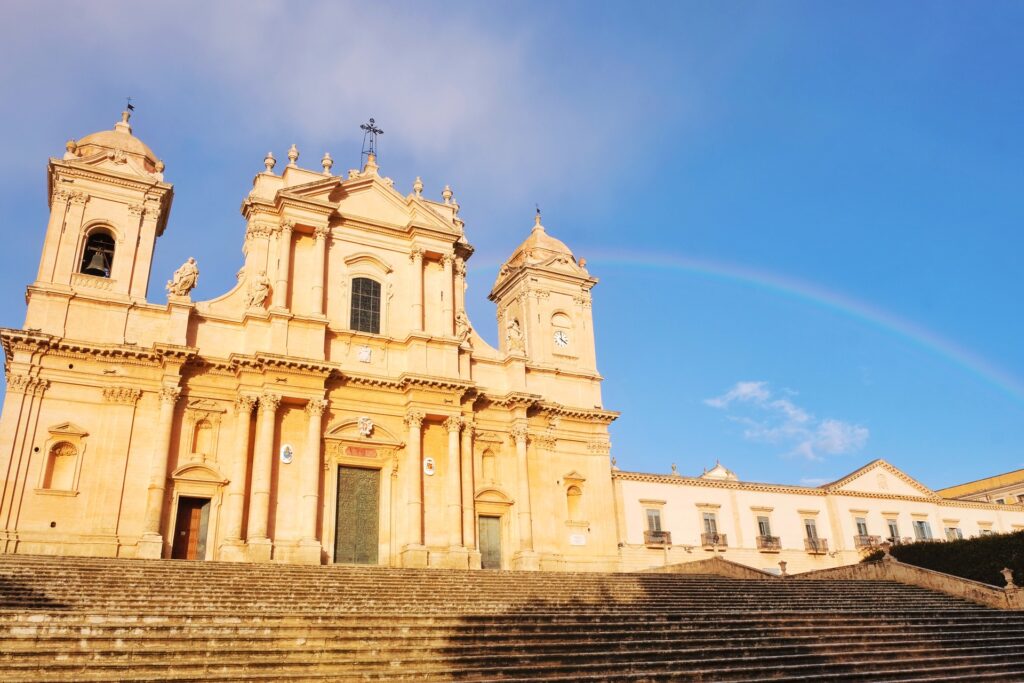
The lingering moisture gave everything a freshly washed look. Even in winter, Noto has this golden warmth to it—the kind of city where you almost expect background music to start playing while you walk.
I tried to find a decent viewpoint but didn’t have much luck nearby. So I browsed a few little shops instead, looking for a souvenir to justify the stop. The drizzle returned—soft, steady, and not particularly motivated—but enough to nudge me indoors again.
Eventually, I ducked into Caffè Sicilia, long praised for its exquisite pastries. I ordered a warm cup of tea and—because it would’ve felt criminal not to—a pastry too. I can’t even tell you what it was. Something almondy, possibly citrusy, and entirely perfect.
The café was dry, warm, and just indulgent enough—a sweet little exhale after a day of layered towns, blurry windows, and one unforgettable flatbread.
Back in Ortigia: Pizza, Packing, and One Last Night
We returned to Ortigia in the early evening, the sky already dark, the air still damp. The streets were quiet again—slick with rain, echoing slightly underfoot. I wandered a little, not really to explore, just to breathe it all in one last time.
Eventually, I settled on Pizzeria da Mario, a humble takeaway spot just a short walk from my building. For €7, I got an entire pizza—still hot in its box by the time I made it back to my room.
I ate it in bed, legs tucked under the covers, wind curling past the window, while my final set of damp clothes dried beside the heater. It wasn’t glamorous, but it was perfect. After days of movement, misadventures, and moisture—I was warm, fed, and still completely enchanted by this place.
Before I turned in, I stepped out onto the balcony for one last look at the sea view. The waves were barely visible in the dark, but I could hear them. There was something quietly grounding about it—like Ortigia’s way of saying goodbye without making a fuss.
The next morning, I took a short ride to the bus station. As we left the island behind, Ortigia slipped past the window—stone buildings, narrow alleys, a flash of sea. It was all so familiar now. I felt a small pang of sadness watching it blur away.
I was now heading west—leaving Sicily’s eastern coast behind and crossing the island toward Palermo. But part of me was still very much on that little island, watching cats sun themselves on warm stone and hearing the sea breathe in and out like it had all the time in the world.
Final Thoughts: Why Ortigia Casts a Spell
Ortigia was the most restful chapter of my Sicilian adventure—but mostly because the weather left me no choice. Storms, downpours, and endless drizzle forced me to slow down, linger indoors, and trade ambitious plans for quiet walks and hot meals. And honestly? I didn’t mind.
There’s something about Ortigia’s easygoing rhythm—its quiet mornings, gentle sea views, and winding stone lanes—that wraps around you without trying too hard. It’s not a city that demands. It just invites. To stay a little longer, to wander a little slower, to notice the small things: a ceramic fish in a shop window, golden light on cathedral walls, a cat with a fake limp angling for a bite of your sandwich.
It was the most chaotic part of my trip too—because of course, the biggest storm had to happen in the place with the most fragile balcony shutters. But even soaked to the bone and windblown, I found myself smiling. Ortigia didn’t try to impress me. It just existed—beautiful, battered, a little unpredictable. Like a poem left out in the rain.
As I crossed the island from east to west the next day, I realised I wasn’t quite ready to leave that slow spell behind. And I suspect that’s the magic of Ortigia: it doesn’t rush you, but it stays with you, long after you’ve gone.
For travellers craving beauty, authenticity, and a place that softens your pace without asking, Ortigia delivers in spades.
Continue reading: Winter in Palermo – A Travel Story of Rain and Resilience
Plan Your Own Trip to Ortigia, Sicily
Visit
- Piazza Duomo & Cathedral of Syracuse (Duomo di Siracusa) – A grand Baroque square built atop an ancient Greek temple. Glows at golden hour. Bring a camera.
- Fonte Aretusa – A freshwater spring by the sea, wrapped in myth. Worth a stroll-by, even if you’re not into nymphs.
- Ortigia Market – Fresh produce, salty locals, and that famous sandwich spot you’ve seen on TikTok.
- Lungomare Alfeo – A coastal promenade lined with bars. Come for the Aperol Spritz, stay for the sunset.
- Archaeological Park of Neapolis (Parco Archeologico della Neapolis) – In mainland Syracuse. Home to the Ear of Dionysius and some cinematic Indiana Jones energy.
- Sanctuary Basilica of Our Lady of Tears (Basilica Santuario Madonna delle Lacrime) – Also in mainland Syracuse. A strange and striking modernist church you’ll wish you stepped inside (I didn’t).
- Take a boat tour – Best in warmer months (unlike my rainy winter escapade), Explore Ortigia from the sea. These tours often take you around the island’s caves and coastline, offering a fresh and photogenic perspective of the city.
Shop
- Fish House Art – A charming ceramic store filled with all things marine-inspired, run by an old man and his cat.
- TAMI’ Concept Store – Great for postcards and tasteful souvenirs.
- Good Vibes Ortigia – Unique fashion accessories, and you might meet the resident cat at the door
- Flying Tiger Copenhagen – For emergency duct tape, cute finds, or just browsing like it’s Daiso.
Eat
- Caseificio Borderi (Ortigia Market) – The famous sandwich shop that may or may not live up to the hype.
- Zenzero – A cosy vegan spot run by an elderly couple. Perfect for rainy nights and solo diners.
- Pizzeria Schiticchio – A friendly pizza place ideal for dinners with new friends.
- Pizzeria da Mario – A €7 whole pie on your final night? Yes, please.
- Piccolo Bar (Modica) – Eat all the scacce ragusane for me.
- Caffè Sicilia (Noto) – Legendary pastries, elegant setting, worth the sugar.
Stay
- Camere A’ Marina – The little B&B I stayed in and would stay forever if I could. Sea view, steep stairs, no regrets.
Getting There & Around
- Arrival: Take the train from Catania to Syracuse (Siracusa)—about 1.5 hours. From there, Ortigia is a 20-minute walk or a short taxi ride.
- Getting Around: Walk. Ortigia is compact, mostly flat, and full of small discoveries.
- Day Trips: To visit the Baroque trio—Ragusa, Modica, and Noto—consider a driver service like Sicily In Travel. You’ll avoid the hassle of multiple transfers and the risk of getting very charmingly lost.rer and the streets more lively.
Keep Exploring Sicily
If you enjoyed this story, you might also like:
- Taormina in Winter: A Solo Traveler’s Peaceful Escape
- New Year in Catania – My Winter Trip to Sicily’s Black City
- Winter in Palermo – A Travel Story of Rain and Resilience
Along the way, I squeezed in unforgettable side trips to places like Savoca, Mount Etna, Cefalù, and the Valley of the Temples. Each one added a different color to the Sicilian palette.
